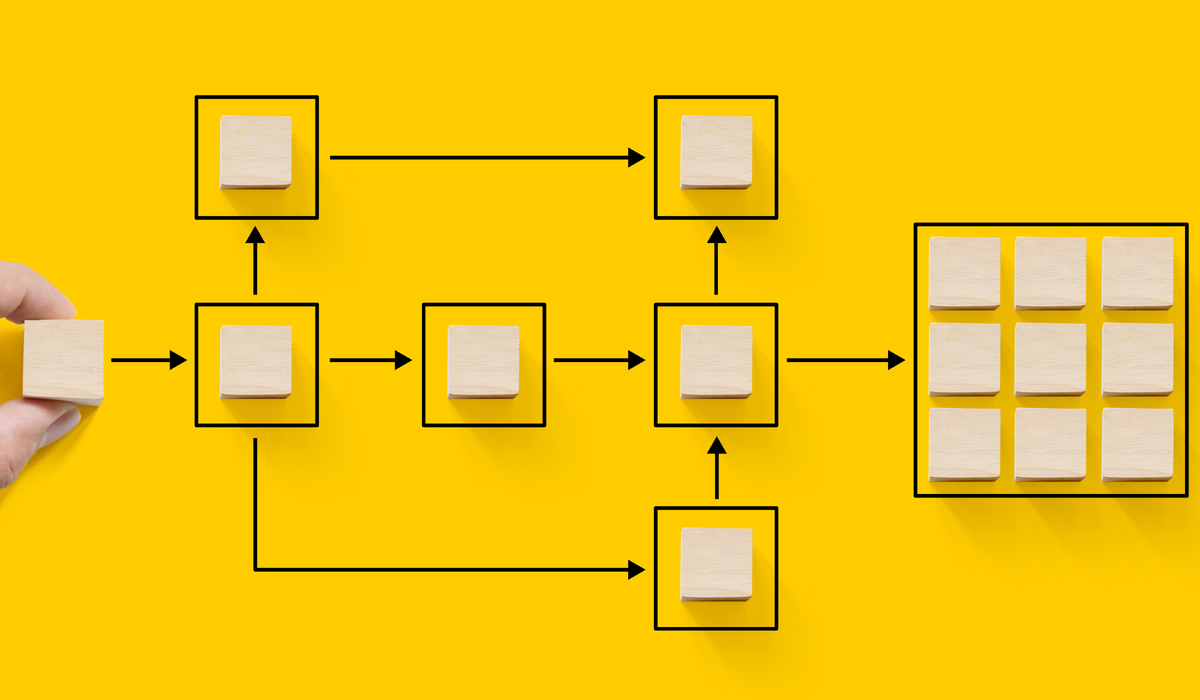SECTION
The Crucial Role of Goal Alignment in Performance Management

Listen to this article:
Note: The article was updated on April 17, 2024, with strategies for ensuring goal alignment, tips for leveraging technology, and an example of a company that has achieved goal alignment in performance management.
In every company, there's a collective ambition to excel, with dedicated individuals eager to contribute their skills and drive projects to success. And yet, despite all their good intentions, sometimes the needle doesn't seem to budge. There's a lot of activity but no striking results. The company's performance could be improved. Resources are going underutilized, and morale is taking a nosedive.
As an executive, you're likely pondering the missing link. Organizational alignment, along with a well-put strategy and resources, is the process that holds the key to getting teams pulling in the same direction.
In this article, we delve into the critical role of alignment in shaping business results. Discover how aligning objectives fuels organizational success and propels individual performance. Read on to discover how to achieve goal alignment in performance management.
What is goal alignment in performance management?
Organizational alignment means organizing all the elements of a business, from strategy to department segmentation and procedures, in the best manner for bringing the company's mission to life.
In performance management, organizational alignment refers to synchronizing individual and team goals with company objectives. This process ensures everyone's efforts are directed toward achieving broader strategic priorities. It also entails that individuals' and teams' performance is partly evaluated through objective completion and their impact on business growth.

Importance of goal alignment in driving business outcomes
Studies from around the world have shown that unity doesn’t just look good on paper; it actually works. For example, highly aligned companies increase their revenue by 58% and are 72% more profitable. And, when goals and accountabilities are crystal clear, people are 2.8x more likely to be highly engaged at work.
When you achieve organizational alignment, the entire business thrives and grows. People understand exactly what their roles and objectives are in the company and are pulling together in the same direction. When your employees collaborate and help each other accomplish their goals, the business prospers and has better results.
On the other hand, an unaligned company can lead to confusion and disorganization. Despite clear long-term objectives, operational difficulties can result in teams and departments working in silos, which is inefficient and counterproductive.
👉 Suggested reading: The Importance of Performance Management
Benefits of organizational alignment
We mentioned how important it is to build organizational alignment in your company to drive success. Let’s examine the benefits of organizational alignment and how they can assist your company’s growth.
- Optimized roles and responsibilities. When a company is balanced, each individual covers the tasks that best suit their skills. Plus, they understand the bigger picture and how they fit into it.
- Increased collaboration among teams. If attention is paid to alignment, people can communicate better, reach agreements, and work together to achieve common goals.
- More transparency and accountability. Aligned teams understand their role and responsibilities within the company, how they affect other departments, and the desired outcome of projects.
- Fewer resources wasted. Careful planning leads to wiser resource use and less overlap in roles. This reduces the chances of doubling the work, saving everyone time and money.
- Faster decision-making. Thanks to shared company-wide information rather than siloed, teams can make strategic decisions faster.
- Better working environment. Reaching for the same goals helps lighten the mood at work, increase employee engagement, and reduce the number of conflicts.
However, most companies are not aligned and don't enjoy these benefits. In fact, 97% of team members and executives believe an internal lack of convergence impacts the outcome of their projects. It doesn't take a crystal ball to guess that the lack of alignment in your company has a high cost.
6 strategies for ensuring goal alignment across teams
Now that we have clarified what goal alignment in performance management is, the question remains, "How do I achieve it?" This section covers six steps to achieve individual, team, and organizational alignment.

Set clear and measurable objectives
Team alignment starts at the top, so the first thing you should do as leaders is agree on the precise organizational objectives you aim to accomplish.
Start with the overall strategic directions, thinking long and medium-term. Then, ensure organizational goals are clear, measurable, targeted, and built around the company's strategic directions. Remember that the more precise the goals, the easier it will be for your teams to understand your vision, align with the organizational goals, and work together to achieve them.
Communicate goals effectively
If you want to boost alignment in your team, get everyone on board by clearly communicating your common purpose as a group.
Explain how your business strategy advances your purpose and vision and keep it true to your core values.
Ask for feedback, offering team members insights into how their objectives contribute to the organization's goals. Feedback also serves as a mechanism for identifying discrepancies that could lead to confusion or hinder progress. Leveraging HR metrics and tools, such as employee feedback software, combined with workforce segmentation, can enhance performance and improve communication by tailoring actions to the specific needs of different employee groups.
Involve your people in the goal-setting process
Although goal alignment starts with the leadership's vision, modern companies understand that involving team members is equally important. After all, your people are experts in their fields and know how to contribute to the overall business goals.
So, after you've ensured that everyone knows the common purpose and main strategic directions, you need to translate them into OKRs, which will help your team gain focus and clarity.
This collaborative approach can be facilitated during performance check-ins, allowing managers and employees to engage in a constructive dialogue regarding their objectives for the upcoming period. Discussions can center on defining what they aim to accomplish, how progress will be gauged, and the resources necessary for success.
By prioritizing getting everyone on the same page, you create a high-performance environment driving sustainable results, both short and long-term.
Encourage collaboration and communication between teams
Organizational alignment requires a highly coordinated effort from all levels of teams, departments, and individuals. While taking responsibility and owning specific tasks is important, in an aligned work environment, people must know they can rely on each other.
My 20+ years of experience leading companies has taught me that collaboration is essential for cross-functional alignment, breaking down silos, and promoting synergy.
At Zitec, implementing an all-hands meeting every two weeks and short daily team syncs proved invaluable in maintaining alignment. These team gatherings provide a platform to discuss progress, goals, and other pertinent information, ensuring everyone remains synchronized.
Provide support and resources for employees
You've set the framework for achieving goal alignment in performance management, but more is needed to ensure continuity. A true leader knows that empowering people with the necessary resources and support is essential.
Here are a couple of ways you can do that:
- Offer training programs and workshops on goal setting and alignment;
- Equip people with the skills and knowledge needed to align their objectives with broader strategic priorities;
- Provide access to tools and technologies that facilitate goal tracking and progress monitoring;
- Help your people stay on course and adapt to changing priorities by maintaining open communication.
Measure and evaluate the effectiveness of your goal alignment initiatives
The last step of the process is goal alignment tracking. After all, you can’t assess the results of something you don’t measure and evaluate regularly.
Every successful business leader will tell you that data is invaluable for measuring progress, and you must handle it properly to see results.
With appropriate tracking measures, individuals and teams know what works and does not and keep on top of their targets. It also allows you to quickly detect errors, adapt, and change courses as necessary.
Here are the most notable metrics and indicators to track progress towards goal alignment:
- Objective completion: measures the percentage of set goals that have been achieved within a specific timeframe. This metric provides insight into the overall effectiveness of goal alignment efforts.
- Alignment ratio evaluates the extent to which individual or team goals are aligned with organizational objectives. This ratio helps assess goals' strategic relevance and contribution to overarching priorities.
- Employee engagement levels: monitor employee engagement surveys or feedback mechanisms to gauge the extent to which employees feel aligned with organizational goals and understand their role in achieving them.
The best method to evaluate the impact of goal alignment on performance management is through performance check-ins. Encourage managers to discuss how they feel about their contributions to the organization's goals with their mentees.
When evaluating people's performance, in addition to looking at objective completion, it is recommended that managers take into account the overall contribution people bring to the organization's success through collaboration and teamwork.
How to leverage technology for effective goal alignment in performance management
In this digital age, you don't have to do it alone. With proven results, performance management software like Mirro puts all the frameworks and support you need at your fingertips.
Tools for strategic alignment make strategic priorities transparent. With the right technology, you can depict the organizational structure, enabling people to understand how their efforts contribute to achieving organizational goals.
Mirro is the perfect OKR software that can help you reach the state of team alignment.
The nifty Mirro app allows your company to:
- Break down the company's strategy into OKRs, clarifying and highlighting priorities.
- Align team members with the goals that fit them best, playing to their strengths.
- Promote accountability, spot and remove obstacles, and offer timely feedback.
- Bake team alignment into effective 1 on 1 meetings, reminding everyone what an important part they play in the organization's success.
- Connect initiative and decisions to the underlying strategy.
- Offer robust onboarding to new hires so that they quickly understand the impact generated by their work.
- Stay agile and on top of changing priorities, empowering team members to execute the vision.
The final result is complete visibility over strategy implementation, collaborative teams, a strong direction, and fulfilled potential.

Case study: successful goal alignment implementations
So, how does a successful goal alignment implementation in an organization look like?
Zitec is a software company specializing in online products and application development that has approximately 400 employees today.
The company knows that the employees are the key to success, but how do you align 400 people to the same vision and mission? Performance management is the perfect opportunity to align individual efforts with company goals.
To do that, Zitec uses the OKR methodology to set quarterly goals. The leadership team sets the company's direction and establishes organizational goals. Then, each department, team, and individual aligns their OKRs with the company goals.
Zitec uses Mirro, the OKR tracking software, to align their teams to company objectives and understand performance. With the help of Mirro, Zitec's leadership can add objectives at any level (organizational, departmental, team, or individual), know who does what at all times, and get an overview of OKR progress with intuitive dashboards.

See everything at a glance with Mirro.
Managers have weekly check-ins with their mentees, and each team gets together weekly or monthly to discuss progress, misalignment, or blockers. They also hold quarterly team meetings to assess OKRs' completion and determine what's working and what's not.
The Zitec approach is the perfect example of how businesses can strategically connect individual goals with team and company goals to achieve better business results. By doing this, employees gain an understanding of the company's priorities and how their contributions can have a beneficial impact.
Final thoughts
When leaders know how to effectively align organizational, team, and individual goals, peak performance follows. Although it can feel daunting, reaching goal alignment in performance management is the most straightforward method of getting everyone on the same page.
By adopting goal alignment, leaders can cultivate a cohesive and driven work environment, contributing to sustained success. Goal alignment should be your priority to build a high-performing team.






